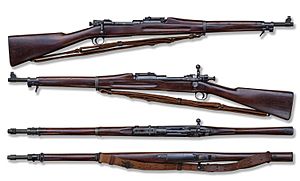M1903 Springfield facts for kids
Quick facts for kids M1903 Springfield |
|
|---|---|
 |
|
| Type | Bolt-action rifle |
| Place of origin | United States |
| Service history | |
| In service |
|
| Used by | See Users |
| Wars |
|
| Production history | |
| Designed | 1903 |
| Manufacturer |
|
| Unit cost | $41.35 (1938), equal to $860 now |
| Produced | 1903–1949 |
| No. built | 3,004,079 |
| Variants | See Variants |
| Specifications | |
| Mass | 8.7 lb (3.9 kg) |
| Length | 43.2 in (1,100 mm) |
| Barrel length | 24 in (610 mm) |
|
|
|
| Cartridge |
|
| Action | Bolt action |
| Rate of fire | User dependent; usually 15 to 30 rounds per minute |
| Muzzle velocity | 2,800 ft/s (850 m/s) |
| Effective firing range | 100–300 yd (91–274 m) |
| Maximum firing range | 5,500 yd (5,000 m) with .30 M1 ball cartridge |
| Feed system | 5-round stripper clip, 25-round (air service variant) internal box magazine |
| Sights |
|
| Blade type | Bayonet |
The M1903 Springfield was a very important rifle used by the United States military. It was a type of rifle called a bolt-action rifle, which means you had to pull a lever (the bolt) back and forth to load each new bullet. It held five bullets at a time in its internal magazine.
This rifle was first used in battle during the Philippine–American War. The U.S. military officially adopted it on June 19, 1903. It was the main rifle for soldiers during World War I. Later, a faster, semi-automatic rifle called the M1 Garand began to replace it in 1936.
However, the M1903 Springfield was still widely used during World War II. This was because the U.S. did not have enough M1 Garand rifles for all its soldiers. It also remained a key sniper rifle during World War II, the Korean War, and the Vietnam War. Today, many people still enjoy the M1903 as a collector's item or for competitive shooting.
Contents
What is the M1903 Springfield Rifle?
The M1903 Springfield is a type of bolt-action rifle. This means that after each shot, the shooter must manually operate a bolt to remove the empty cartridge and load a new one. This action is done by hand, making it slower than automatic or semi-automatic rifles. The rifle was designed to use a special type of bullet called the .30-06 Springfield.
How Was the M1903 Designed?
The M1903 Springfield was based on a famous German rifle called the Mauser Gewehr 98. The U.S. Army wanted a modern rifle that could use new, more powerful smokeless powder. This new powder made bullets travel faster and farther. The Springfield Armory, a U.S. government factory, made the first M1903 rifles.
Key Features of the Rifle
- Bolt-Action System: This system was very strong and reliable. It helped the rifle work well in tough conditions.
- Magazine: The rifle had an internal magazine that held five rounds. Soldiers could load these quickly using a "stripper clip."
- Sights: Early versions had a flip-up rear sight. Later models, like the M1903A3, had a more modern "aperture" sight, which was easier to aim.
- Bayonet: Soldiers could attach a bayonet, a knife-like blade, to the end of the rifle for close combat.
When Was the M1903 Springfield Used?
The M1903 Springfield served the U.S. military for many years. It was a very important weapon in several major conflicts.
Service in World War I
The M1903 Springfield was the main rifle for American soldiers during World War I (1914-1918). It was known for being accurate and dependable. Many soldiers relied on it in the trenches of Europe.
Role in World War II
Even though the M1 Garand was newer, the M1903 Springfield played a big role in World War II (1939-1945). The U.S. needed many rifles quickly, so factories continued to make the M1903. It was especially important for snipers, who needed its accuracy for long-range shots.
Later Use as a Sniper Rifle
After World War II, the M1903 Springfield continued to be used as a sniper rifle. Its accuracy made it a favorite for this specialized role. It saw limited use in the Korean War and even the early parts of the Vietnam War.
Who Made the M1903 Springfield?
Several factories helped produce the M1903 Springfield rifle.
- Springfield Armory: This was the main government factory that designed and first produced the rifle.
- Rock Island Arsenal: Another government factory that helped make many M1903s.
- Remington Arms Company: A private company that started making the rifles during World War II to meet the high demand.
- Smith Corona: Another private company that produced the M1903A3 variant during World War II.
Different Types of M1903 Rifles
Over the years, the M1903 Springfield had a few different versions, or "variants." These changes were often made to improve the rifle or make it easier to produce.
- M1903: The original version, used in World War I.
- M1903A1: A slightly improved version with a different stock (the part you hold).
- M1903A3: This version was made during World War II. It had simpler sights and was easier to mass-produce quickly.
- M1903A4: This was the sniper version of the rifle. It had a special scope attached for very accurate long-range shooting.
M1903 Springfield Today
Even though it's no longer a standard military rifle, the M1903 Springfield is still popular.
- Collectors: Many people collect these rifles because of their history.
- Shooting Sports: Some people use them in shooting competitions.
- Drill Rifles: They are still used by military and school drill teams for parades and ceremonies.
See also
 In Spanish: Springfield M1903 para niños
In Spanish: Springfield M1903 para niños

